International Marketing Plan: Healthy Care's India Entry Strategy
VerifiedAdded on 2022/11/13
|17
|3709
|4
Report
AI Summary
This report outlines an international marketing plan developed for Healthy Care, an Australian natural health brand, focusing on its potential entry into the Indian market. The report begins with an executive summary and background information on Healthy Care and the Indian market, emphasizing the growing demand for natural health products. A thorough market analysis is conducted, examining the business, regulatory, economic, social, demographic, and natural environments. The analysis also assesses the nature of demand for the selected product, Bio Turmeric 3000, including market size, product life cycle stage, and competitive structure. A SWOT analysis identifies internal strengths and weaknesses, as well as external opportunities and threats. Based on this analysis, the report proposes specific international and market objectives, recommending a direct exporting market entry strategy targeting the middle and upper-middle class suffering from swelling and joint inflammation. The marketing mix strategies are then detailed, covering product and branding, place (distribution), price, and promotion strategies, with justifications for each element. The report concludes with a list of references.
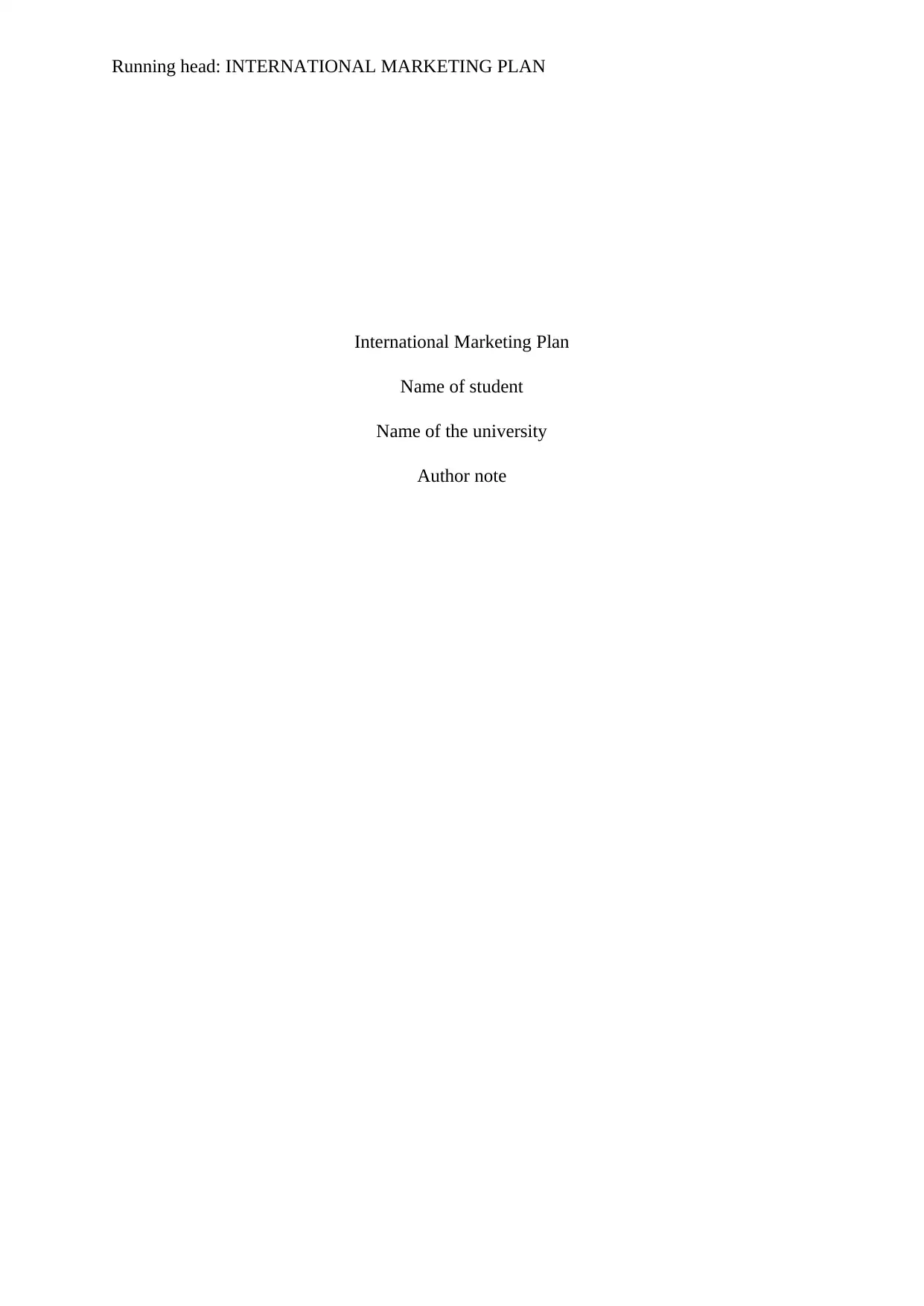
Running head: INTERNATIONAL MARKETING PLAN
International Marketing Plan
Name of student
Name of the university
Author note
International Marketing Plan
Name of student
Name of the university
Author note
Paraphrase This Document
Need a fresh take? Get an instant paraphrase of this document with our AI Paraphraser
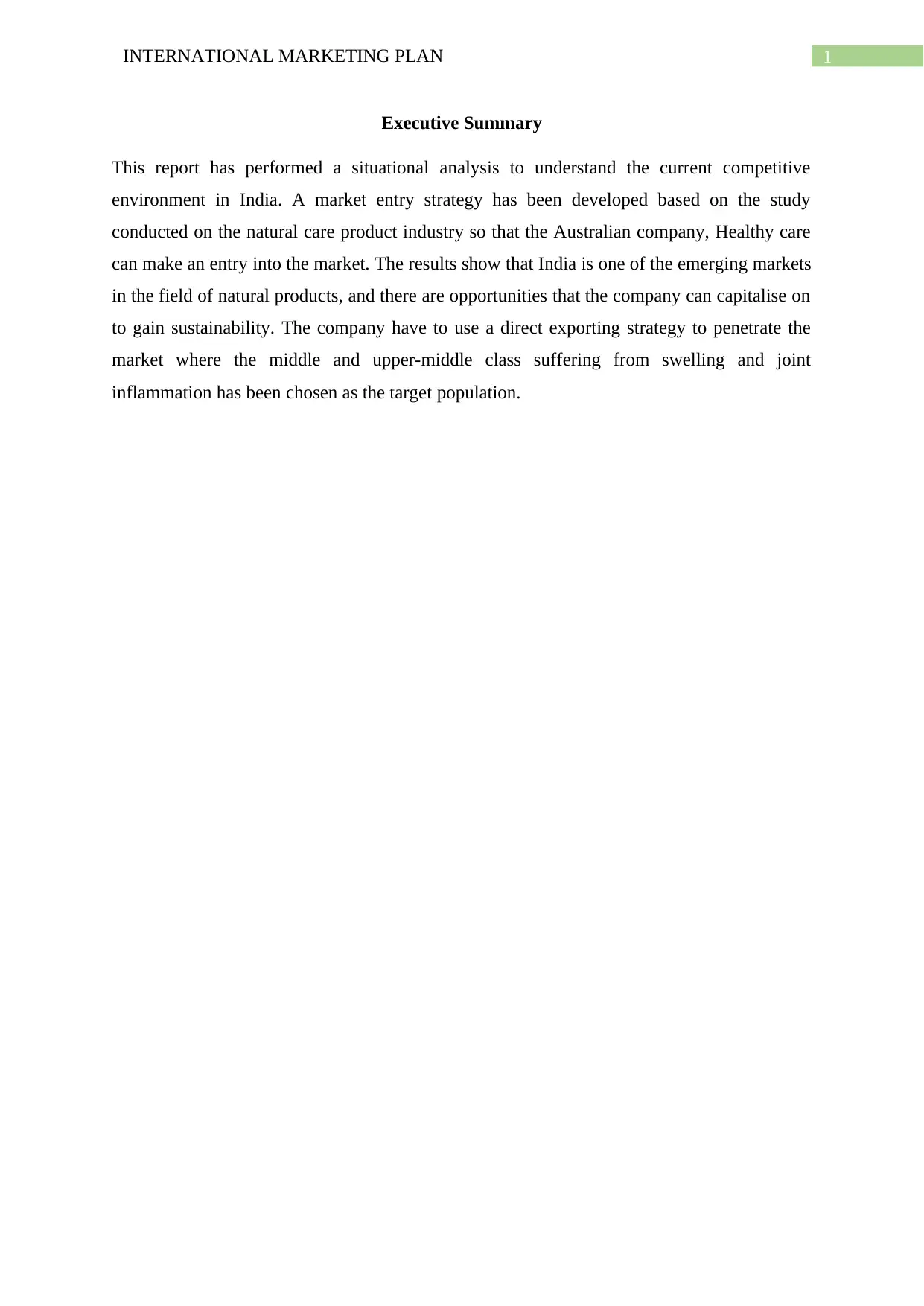
1INTERNATIONAL MARKETING PLAN
Executive Summary
This report has performed a situational analysis to understand the current competitive
environment in India. A market entry strategy has been developed based on the study
conducted on the natural care product industry so that the Australian company, Healthy care
can make an entry into the market. The results show that India is one of the emerging markets
in the field of natural products, and there are opportunities that the company can capitalise on
to gain sustainability. The company have to use a direct exporting strategy to penetrate the
market where the middle and upper-middle class suffering from swelling and joint
inflammation has been chosen as the target population.
Executive Summary
This report has performed a situational analysis to understand the current competitive
environment in India. A market entry strategy has been developed based on the study
conducted on the natural care product industry so that the Australian company, Healthy care
can make an entry into the market. The results show that India is one of the emerging markets
in the field of natural products, and there are opportunities that the company can capitalise on
to gain sustainability. The company have to use a direct exporting strategy to penetrate the
market where the middle and upper-middle class suffering from swelling and joint
inflammation has been chosen as the target population.
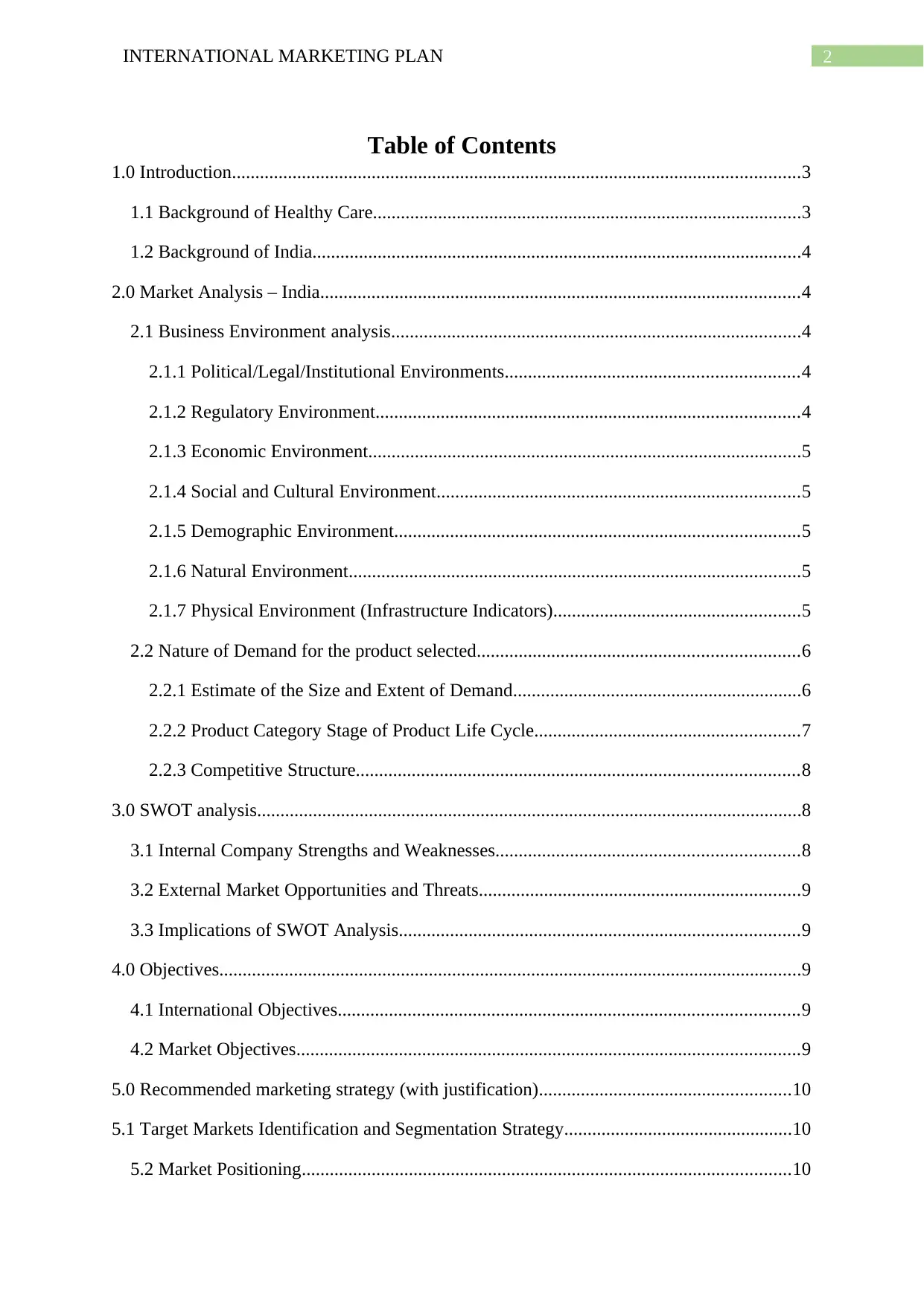
2INTERNATIONAL MARKETING PLAN
Table of Contents
1.0 Introduction..........................................................................................................................3
1.1 Background of Healthy Care............................................................................................3
1.2 Background of India.........................................................................................................4
2.0 Market Analysis – India.......................................................................................................4
2.1 Business Environment analysis........................................................................................4
2.1.1 Political/Legal/Institutional Environments...............................................................4
2.1.2 Regulatory Environment...........................................................................................4
2.1.3 Economic Environment.............................................................................................5
2.1.4 Social and Cultural Environment..............................................................................5
2.1.5 Demographic Environment.......................................................................................5
2.1.6 Natural Environment.................................................................................................5
2.1.7 Physical Environment (Infrastructure Indicators).....................................................5
2.2 Nature of Demand for the product selected.....................................................................6
2.2.1 Estimate of the Size and Extent of Demand..............................................................6
2.2.2 Product Category Stage of Product Life Cycle.........................................................7
2.2.3 Competitive Structure...............................................................................................8
3.0 SWOT analysis.....................................................................................................................8
3.1 Internal Company Strengths and Weaknesses.................................................................8
3.2 External Market Opportunities and Threats.....................................................................9
3.3 Implications of SWOT Analysis......................................................................................9
4.0 Objectives.............................................................................................................................9
4.1 International Objectives...................................................................................................9
4.2 Market Objectives............................................................................................................9
5.0 Recommended marketing strategy (with justification)......................................................10
5.1 Target Markets Identification and Segmentation Strategy.................................................10
5.2 Market Positioning.........................................................................................................10
Table of Contents
1.0 Introduction..........................................................................................................................3
1.1 Background of Healthy Care............................................................................................3
1.2 Background of India.........................................................................................................4
2.0 Market Analysis – India.......................................................................................................4
2.1 Business Environment analysis........................................................................................4
2.1.1 Political/Legal/Institutional Environments...............................................................4
2.1.2 Regulatory Environment...........................................................................................4
2.1.3 Economic Environment.............................................................................................5
2.1.4 Social and Cultural Environment..............................................................................5
2.1.5 Demographic Environment.......................................................................................5
2.1.6 Natural Environment.................................................................................................5
2.1.7 Physical Environment (Infrastructure Indicators).....................................................5
2.2 Nature of Demand for the product selected.....................................................................6
2.2.1 Estimate of the Size and Extent of Demand..............................................................6
2.2.2 Product Category Stage of Product Life Cycle.........................................................7
2.2.3 Competitive Structure...............................................................................................8
3.0 SWOT analysis.....................................................................................................................8
3.1 Internal Company Strengths and Weaknesses.................................................................8
3.2 External Market Opportunities and Threats.....................................................................9
3.3 Implications of SWOT Analysis......................................................................................9
4.0 Objectives.............................................................................................................................9
4.1 International Objectives...................................................................................................9
4.2 Market Objectives............................................................................................................9
5.0 Recommended marketing strategy (with justification)......................................................10
5.1 Target Markets Identification and Segmentation Strategy.................................................10
5.2 Market Positioning.........................................................................................................10
⊘ This is a preview!⊘
Do you want full access?
Subscribe today to unlock all pages.

Trusted by 1+ million students worldwide
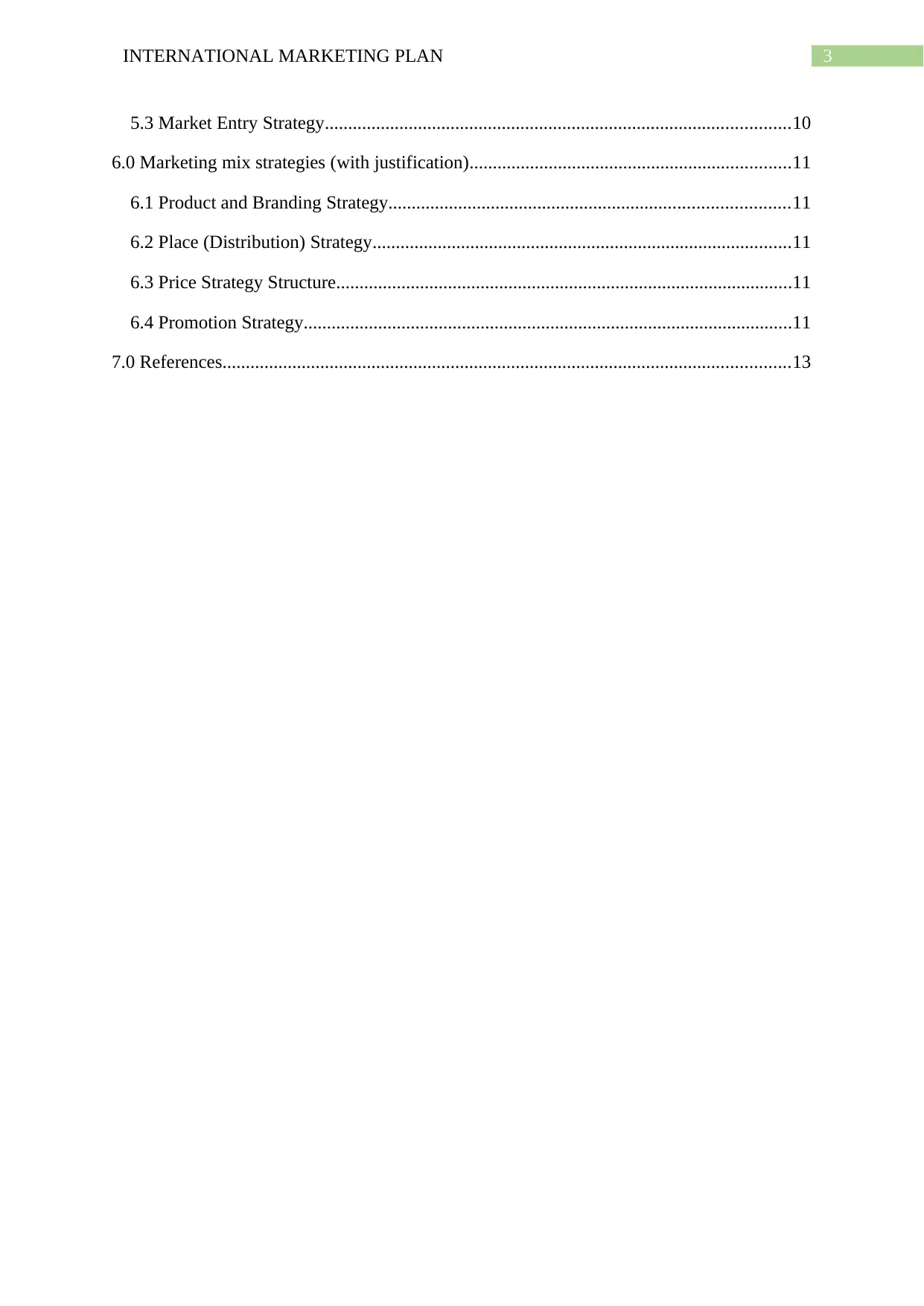
3INTERNATIONAL MARKETING PLAN
5.3 Market Entry Strategy....................................................................................................10
6.0 Marketing mix strategies (with justification).....................................................................11
6.1 Product and Branding Strategy......................................................................................11
6.2 Place (Distribution) Strategy..........................................................................................11
6.3 Price Strategy Structure..................................................................................................11
6.4 Promotion Strategy.........................................................................................................11
7.0 References..........................................................................................................................13
5.3 Market Entry Strategy....................................................................................................10
6.0 Marketing mix strategies (with justification).....................................................................11
6.1 Product and Branding Strategy......................................................................................11
6.2 Place (Distribution) Strategy..........................................................................................11
6.3 Price Strategy Structure..................................................................................................11
6.4 Promotion Strategy.........................................................................................................11
7.0 References..........................................................................................................................13
Paraphrase This Document
Need a fresh take? Get an instant paraphrase of this document with our AI Paraphraser
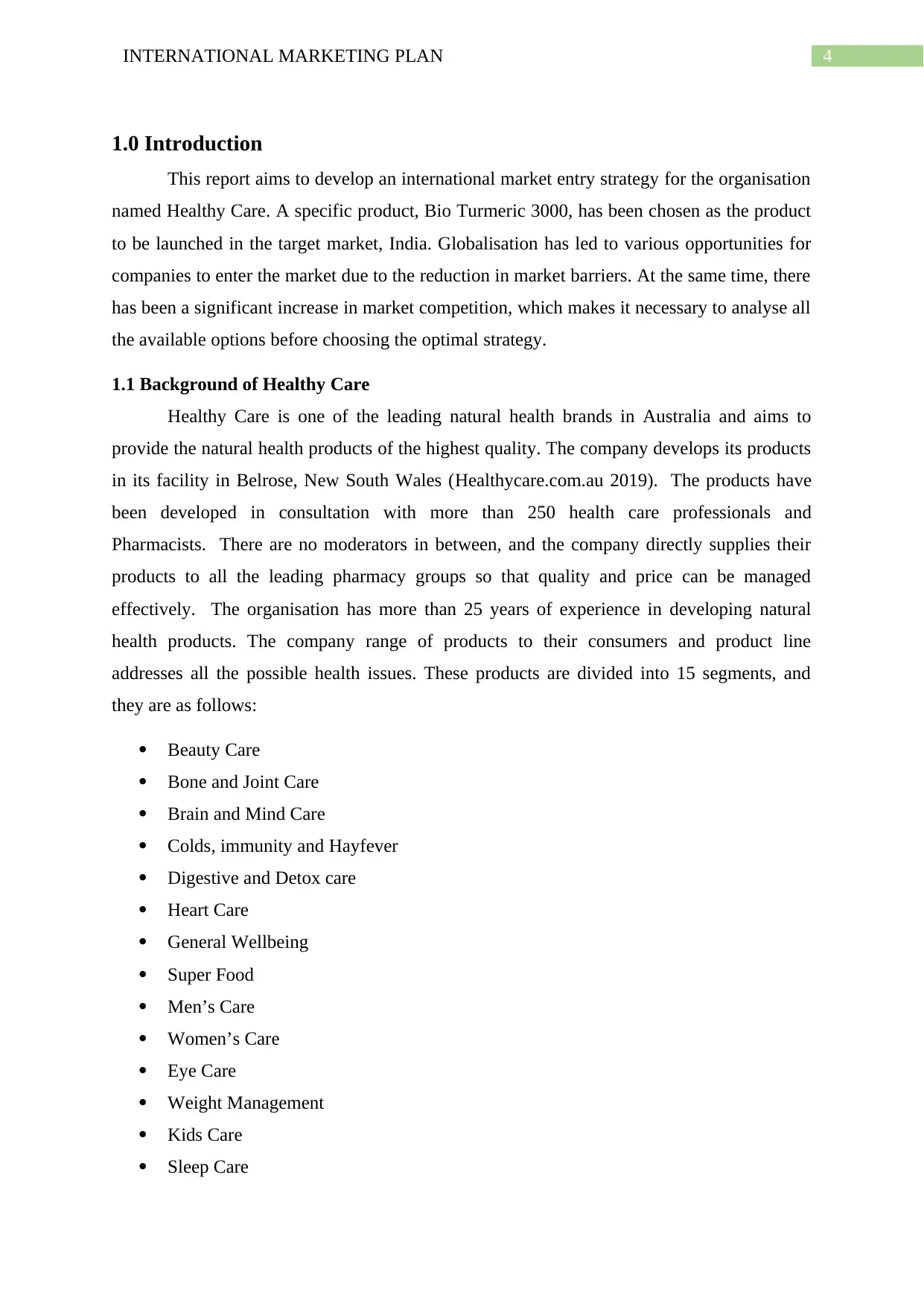
4INTERNATIONAL MARKETING PLAN
1.0 Introduction
This report aims to develop an international market entry strategy for the organisation
named Healthy Care. A specific product, Bio Turmeric 3000, has been chosen as the product
to be launched in the target market, India. Globalisation has led to various opportunities for
companies to enter the market due to the reduction in market barriers. At the same time, there
has been a significant increase in market competition, which makes it necessary to analyse all
the available options before choosing the optimal strategy.
1.1 Background of Healthy Care
Healthy Care is one of the leading natural health brands in Australia and aims to
provide the natural health products of the highest quality. The company develops its products
in its facility in Belrose, New South Wales (Healthycare.com.au 2019). The products have
been developed in consultation with more than 250 health care professionals and
Pharmacists. There are no moderators in between, and the company directly supplies their
products to all the leading pharmacy groups so that quality and price can be managed
effectively. The organisation has more than 25 years of experience in developing natural
health products. The company range of products to their consumers and product line
addresses all the possible health issues. These products are divided into 15 segments, and
they are as follows:
Beauty Care
Bone and Joint Care
Brain and Mind Care
Colds, immunity and Hayfever
Digestive and Detox care
Heart Care
General Wellbeing
Super Food
Men’s Care
Women’s Care
Eye Care
Weight Management
Kids Care
Sleep Care
1.0 Introduction
This report aims to develop an international market entry strategy for the organisation
named Healthy Care. A specific product, Bio Turmeric 3000, has been chosen as the product
to be launched in the target market, India. Globalisation has led to various opportunities for
companies to enter the market due to the reduction in market barriers. At the same time, there
has been a significant increase in market competition, which makes it necessary to analyse all
the available options before choosing the optimal strategy.
1.1 Background of Healthy Care
Healthy Care is one of the leading natural health brands in Australia and aims to
provide the natural health products of the highest quality. The company develops its products
in its facility in Belrose, New South Wales (Healthycare.com.au 2019). The products have
been developed in consultation with more than 250 health care professionals and
Pharmacists. There are no moderators in between, and the company directly supplies their
products to all the leading pharmacy groups so that quality and price can be managed
effectively. The organisation has more than 25 years of experience in developing natural
health products. The company range of products to their consumers and product line
addresses all the possible health issues. These products are divided into 15 segments, and
they are as follows:
Beauty Care
Bone and Joint Care
Brain and Mind Care
Colds, immunity and Hayfever
Digestive and Detox care
Heart Care
General Wellbeing
Super Food
Men’s Care
Women’s Care
Eye Care
Weight Management
Kids Care
Sleep Care
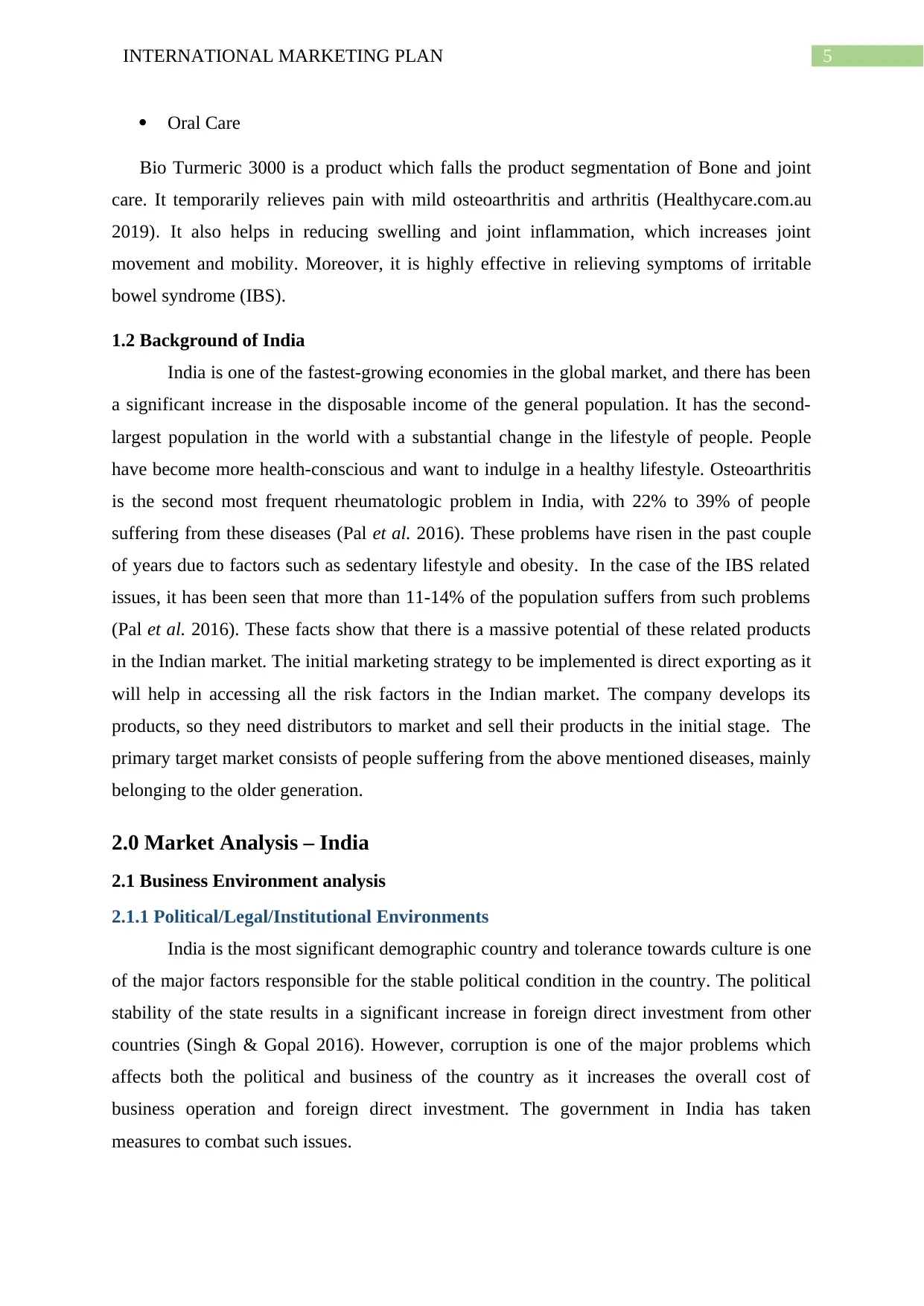
5INTERNATIONAL MARKETING PLAN
Oral Care
Bio Turmeric 3000 is a product which falls the product segmentation of Bone and joint
care. It temporarily relieves pain with mild osteoarthritis and arthritis (Healthycare.com.au
2019). It also helps in reducing swelling and joint inflammation, which increases joint
movement and mobility. Moreover, it is highly effective in relieving symptoms of irritable
bowel syndrome (IBS).
1.2 Background of India
India is one of the fastest-growing economies in the global market, and there has been
a significant increase in the disposable income of the general population. It has the second-
largest population in the world with a substantial change in the lifestyle of people. People
have become more health-conscious and want to indulge in a healthy lifestyle. Osteoarthritis
is the second most frequent rheumatologic problem in India, with 22% to 39% of people
suffering from these diseases (Pal et al. 2016). These problems have risen in the past couple
of years due to factors such as sedentary lifestyle and obesity. In the case of the IBS related
issues, it has been seen that more than 11-14% of the population suffers from such problems
(Pal et al. 2016). These facts show that there is a massive potential of these related products
in the Indian market. The initial marketing strategy to be implemented is direct exporting as it
will help in accessing all the risk factors in the Indian market. The company develops its
products, so they need distributors to market and sell their products in the initial stage. The
primary target market consists of people suffering from the above mentioned diseases, mainly
belonging to the older generation.
2.0 Market Analysis – India
2.1 Business Environment analysis
2.1.1 Political/Legal/Institutional Environments
India is the most significant demographic country and tolerance towards culture is one
of the major factors responsible for the stable political condition in the country. The political
stability of the state results in a significant increase in foreign direct investment from other
countries (Singh & Gopal 2016). However, corruption is one of the major problems which
affects both the political and business of the country as it increases the overall cost of
business operation and foreign direct investment. The government in India has taken
measures to combat such issues.
Oral Care
Bio Turmeric 3000 is a product which falls the product segmentation of Bone and joint
care. It temporarily relieves pain with mild osteoarthritis and arthritis (Healthycare.com.au
2019). It also helps in reducing swelling and joint inflammation, which increases joint
movement and mobility. Moreover, it is highly effective in relieving symptoms of irritable
bowel syndrome (IBS).
1.2 Background of India
India is one of the fastest-growing economies in the global market, and there has been
a significant increase in the disposable income of the general population. It has the second-
largest population in the world with a substantial change in the lifestyle of people. People
have become more health-conscious and want to indulge in a healthy lifestyle. Osteoarthritis
is the second most frequent rheumatologic problem in India, with 22% to 39% of people
suffering from these diseases (Pal et al. 2016). These problems have risen in the past couple
of years due to factors such as sedentary lifestyle and obesity. In the case of the IBS related
issues, it has been seen that more than 11-14% of the population suffers from such problems
(Pal et al. 2016). These facts show that there is a massive potential of these related products
in the Indian market. The initial marketing strategy to be implemented is direct exporting as it
will help in accessing all the risk factors in the Indian market. The company develops its
products, so they need distributors to market and sell their products in the initial stage. The
primary target market consists of people suffering from the above mentioned diseases, mainly
belonging to the older generation.
2.0 Market Analysis – India
2.1 Business Environment analysis
2.1.1 Political/Legal/Institutional Environments
India is the most significant demographic country and tolerance towards culture is one
of the major factors responsible for the stable political condition in the country. The political
stability of the state results in a significant increase in foreign direct investment from other
countries (Singh & Gopal 2016). However, corruption is one of the major problems which
affects both the political and business of the country as it increases the overall cost of
business operation and foreign direct investment. The government in India has taken
measures to combat such issues.
⊘ This is a preview!⊘
Do you want full access?
Subscribe today to unlock all pages.

Trusted by 1+ million students worldwide
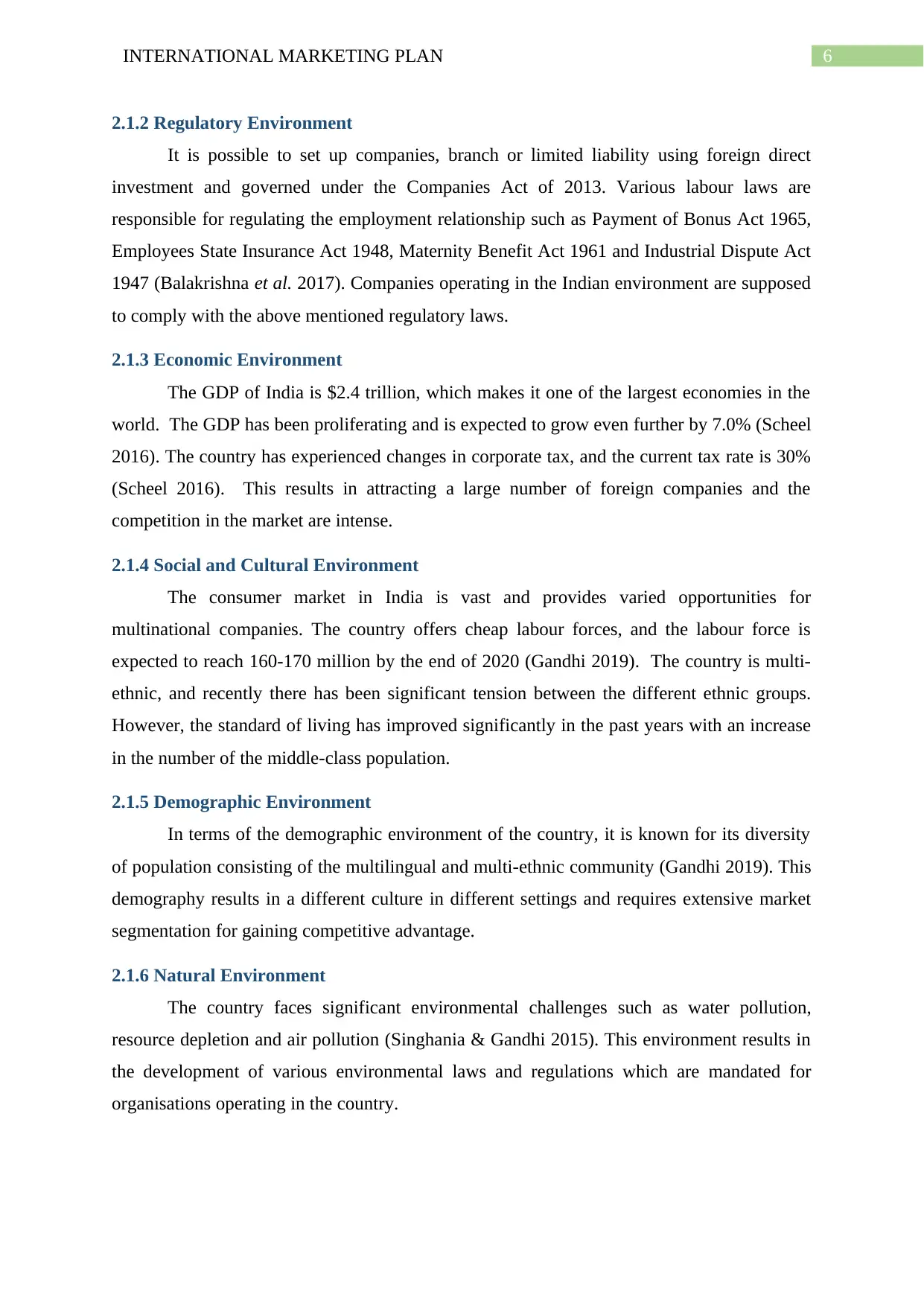
6INTERNATIONAL MARKETING PLAN
2.1.2 Regulatory Environment
It is possible to set up companies, branch or limited liability using foreign direct
investment and governed under the Companies Act of 2013. Various labour laws are
responsible for regulating the employment relationship such as Payment of Bonus Act 1965,
Employees State Insurance Act 1948, Maternity Benefit Act 1961 and Industrial Dispute Act
1947 (Balakrishna et al. 2017). Companies operating in the Indian environment are supposed
to comply with the above mentioned regulatory laws.
2.1.3 Economic Environment
The GDP of India is $2.4 trillion, which makes it one of the largest economies in the
world. The GDP has been proliferating and is expected to grow even further by 7.0% (Scheel
2016). The country has experienced changes in corporate tax, and the current tax rate is 30%
(Scheel 2016). This results in attracting a large number of foreign companies and the
competition in the market are intense.
2.1.4 Social and Cultural Environment
The consumer market in India is vast and provides varied opportunities for
multinational companies. The country offers cheap labour forces, and the labour force is
expected to reach 160-170 million by the end of 2020 (Gandhi 2019). The country is multi-
ethnic, and recently there has been significant tension between the different ethnic groups.
However, the standard of living has improved significantly in the past years with an increase
in the number of the middle-class population.
2.1.5 Demographic Environment
In terms of the demographic environment of the country, it is known for its diversity
of population consisting of the multilingual and multi-ethnic community (Gandhi 2019). This
demography results in a different culture in different settings and requires extensive market
segmentation for gaining competitive advantage.
2.1.6 Natural Environment
The country faces significant environmental challenges such as water pollution,
resource depletion and air pollution (Singhania & Gandhi 2015). This environment results in
the development of various environmental laws and regulations which are mandated for
organisations operating in the country.
2.1.2 Regulatory Environment
It is possible to set up companies, branch or limited liability using foreign direct
investment and governed under the Companies Act of 2013. Various labour laws are
responsible for regulating the employment relationship such as Payment of Bonus Act 1965,
Employees State Insurance Act 1948, Maternity Benefit Act 1961 and Industrial Dispute Act
1947 (Balakrishna et al. 2017). Companies operating in the Indian environment are supposed
to comply with the above mentioned regulatory laws.
2.1.3 Economic Environment
The GDP of India is $2.4 trillion, which makes it one of the largest economies in the
world. The GDP has been proliferating and is expected to grow even further by 7.0% (Scheel
2016). The country has experienced changes in corporate tax, and the current tax rate is 30%
(Scheel 2016). This results in attracting a large number of foreign companies and the
competition in the market are intense.
2.1.4 Social and Cultural Environment
The consumer market in India is vast and provides varied opportunities for
multinational companies. The country offers cheap labour forces, and the labour force is
expected to reach 160-170 million by the end of 2020 (Gandhi 2019). The country is multi-
ethnic, and recently there has been significant tension between the different ethnic groups.
However, the standard of living has improved significantly in the past years with an increase
in the number of the middle-class population.
2.1.5 Demographic Environment
In terms of the demographic environment of the country, it is known for its diversity
of population consisting of the multilingual and multi-ethnic community (Gandhi 2019). This
demography results in a different culture in different settings and requires extensive market
segmentation for gaining competitive advantage.
2.1.6 Natural Environment
The country faces significant environmental challenges such as water pollution,
resource depletion and air pollution (Singhania & Gandhi 2015). This environment results in
the development of various environmental laws and regulations which are mandated for
organisations operating in the country.
Paraphrase This Document
Need a fresh take? Get an instant paraphrase of this document with our AI Paraphraser
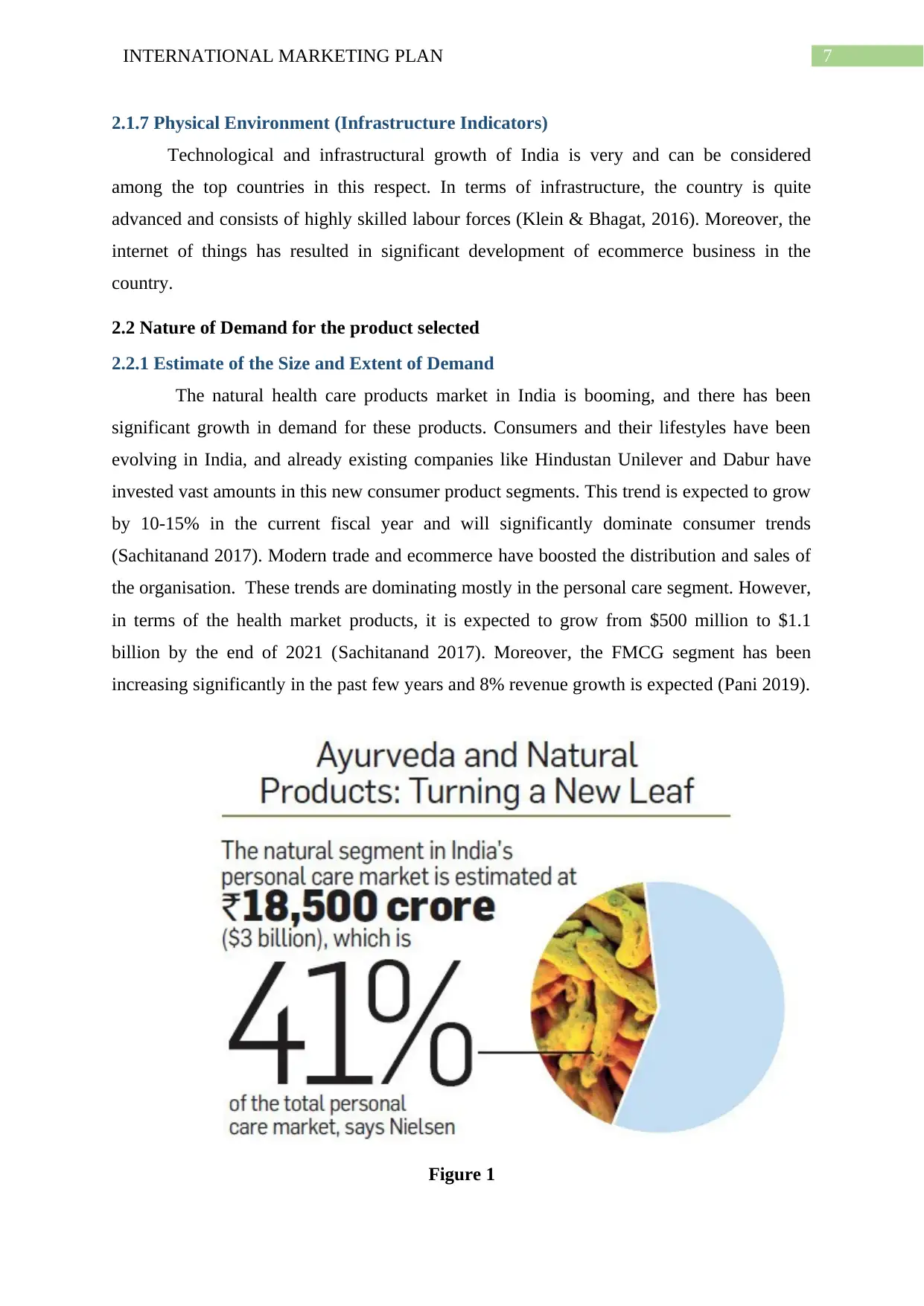
7INTERNATIONAL MARKETING PLAN
2.1.7 Physical Environment (Infrastructure Indicators)
Technological and infrastructural growth of India is very and can be considered
among the top countries in this respect. In terms of infrastructure, the country is quite
advanced and consists of highly skilled labour forces (Klein & Bhagat, 2016). Moreover, the
internet of things has resulted in significant development of ecommerce business in the
country.
2.2 Nature of Demand for the product selected
2.2.1 Estimate of the Size and Extent of Demand
The natural health care products market in India is booming, and there has been
significant growth in demand for these products. Consumers and their lifestyles have been
evolving in India, and already existing companies like Hindustan Unilever and Dabur have
invested vast amounts in this new consumer product segments. This trend is expected to grow
by 10-15% in the current fiscal year and will significantly dominate consumer trends
(Sachitanand 2017). Modern trade and ecommerce have boosted the distribution and sales of
the organisation. These trends are dominating mostly in the personal care segment. However,
in terms of the health market products, it is expected to grow from $500 million to $1.1
billion by the end of 2021 (Sachitanand 2017). Moreover, the FMCG segment has been
increasing significantly in the past few years and 8% revenue growth is expected (Pani 2019).
Figure 1
2.1.7 Physical Environment (Infrastructure Indicators)
Technological and infrastructural growth of India is very and can be considered
among the top countries in this respect. In terms of infrastructure, the country is quite
advanced and consists of highly skilled labour forces (Klein & Bhagat, 2016). Moreover, the
internet of things has resulted in significant development of ecommerce business in the
country.
2.2 Nature of Demand for the product selected
2.2.1 Estimate of the Size and Extent of Demand
The natural health care products market in India is booming, and there has been
significant growth in demand for these products. Consumers and their lifestyles have been
evolving in India, and already existing companies like Hindustan Unilever and Dabur have
invested vast amounts in this new consumer product segments. This trend is expected to grow
by 10-15% in the current fiscal year and will significantly dominate consumer trends
(Sachitanand 2017). Modern trade and ecommerce have boosted the distribution and sales of
the organisation. These trends are dominating mostly in the personal care segment. However,
in terms of the health market products, it is expected to grow from $500 million to $1.1
billion by the end of 2021 (Sachitanand 2017). Moreover, the FMCG segment has been
increasing significantly in the past few years and 8% revenue growth is expected (Pani 2019).
Figure 1
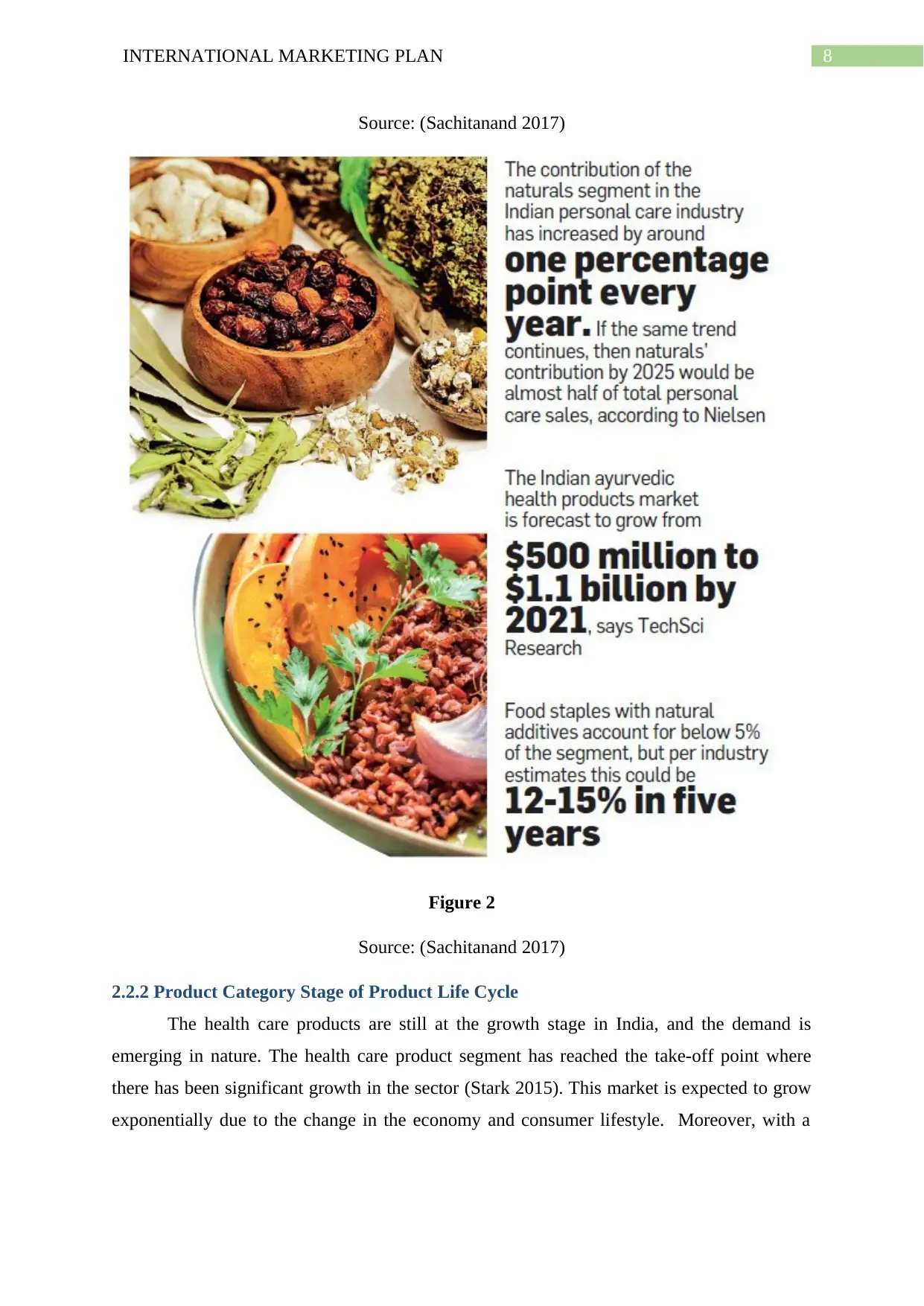
8INTERNATIONAL MARKETING PLAN
Source: (Sachitanand 2017)
Figure 2
Source: (Sachitanand 2017)
2.2.2 Product Category Stage of Product Life Cycle
The health care products are still at the growth stage in India, and the demand is
emerging in nature. The health care product segment has reached the take-off point where
there has been significant growth in the sector (Stark 2015). This market is expected to grow
exponentially due to the change in the economy and consumer lifestyle. Moreover, with a
Source: (Sachitanand 2017)
Figure 2
Source: (Sachitanand 2017)
2.2.2 Product Category Stage of Product Life Cycle
The health care products are still at the growth stage in India, and the demand is
emerging in nature. The health care product segment has reached the take-off point where
there has been significant growth in the sector (Stark 2015). This market is expected to grow
exponentially due to the change in the economy and consumer lifestyle. Moreover, with a
⊘ This is a preview!⊘
Do you want full access?
Subscribe today to unlock all pages.

Trusted by 1+ million students worldwide
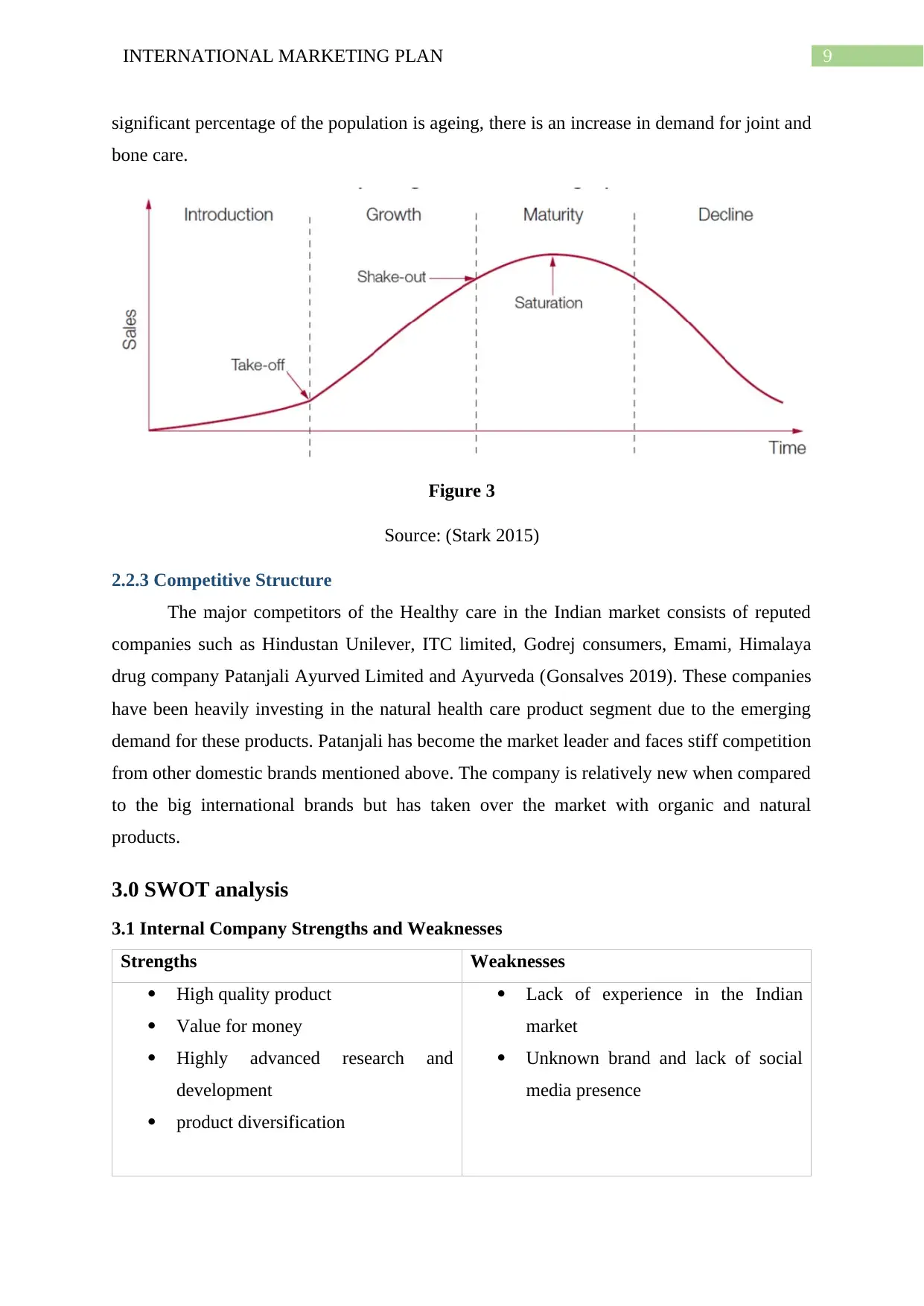
9INTERNATIONAL MARKETING PLAN
significant percentage of the population is ageing, there is an increase in demand for joint and
bone care.
Figure 3
Source: (Stark 2015)
2.2.3 Competitive Structure
The major competitors of the Healthy care in the Indian market consists of reputed
companies such as Hindustan Unilever, ITC limited, Godrej consumers, Emami, Himalaya
drug company Patanjali Ayurved Limited and Ayurveda (Gonsalves 2019). These companies
have been heavily investing in the natural health care product segment due to the emerging
demand for these products. Patanjali has become the market leader and faces stiff competition
from other domestic brands mentioned above. The company is relatively new when compared
to the big international brands but has taken over the market with organic and natural
products.
3.0 SWOT analysis
3.1 Internal Company Strengths and Weaknesses
Strengths Weaknesses
High quality product
Value for money
Highly advanced research and
development
product diversification
Lack of experience in the Indian
market
Unknown brand and lack of social
media presence
significant percentage of the population is ageing, there is an increase in demand for joint and
bone care.
Figure 3
Source: (Stark 2015)
2.2.3 Competitive Structure
The major competitors of the Healthy care in the Indian market consists of reputed
companies such as Hindustan Unilever, ITC limited, Godrej consumers, Emami, Himalaya
drug company Patanjali Ayurved Limited and Ayurveda (Gonsalves 2019). These companies
have been heavily investing in the natural health care product segment due to the emerging
demand for these products. Patanjali has become the market leader and faces stiff competition
from other domestic brands mentioned above. The company is relatively new when compared
to the big international brands but has taken over the market with organic and natural
products.
3.0 SWOT analysis
3.1 Internal Company Strengths and Weaknesses
Strengths Weaknesses
High quality product
Value for money
Highly advanced research and
development
product diversification
Lack of experience in the Indian
market
Unknown brand and lack of social
media presence
Paraphrase This Document
Need a fresh take? Get an instant paraphrase of this document with our AI Paraphraser
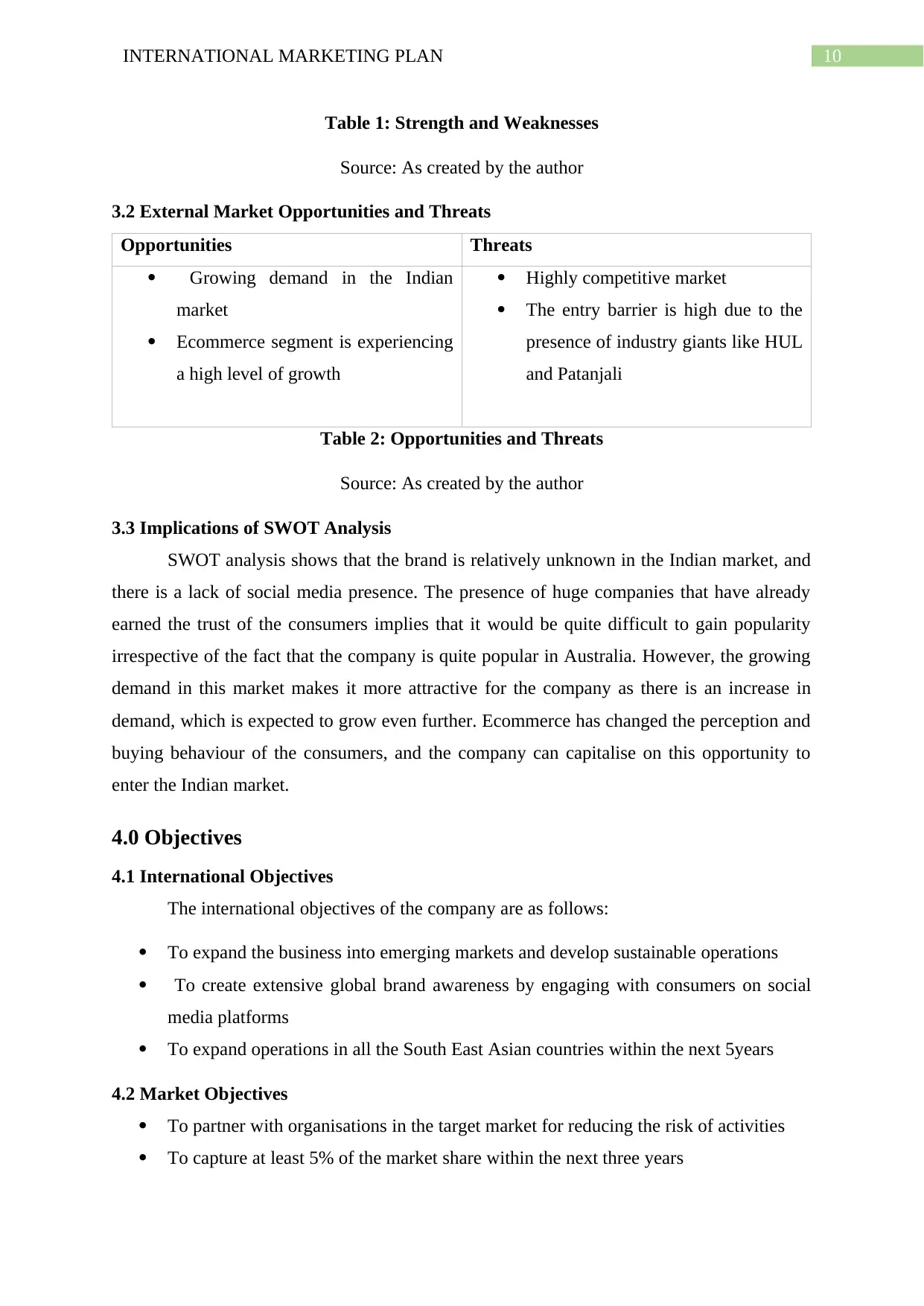
10INTERNATIONAL MARKETING PLAN
Table 1: Strength and Weaknesses
Source: As created by the author
3.2 External Market Opportunities and Threats
Opportunities Threats
Growing demand in the Indian
market
Ecommerce segment is experiencing
a high level of growth
Highly competitive market
The entry barrier is high due to the
presence of industry giants like HUL
and Patanjali
Table 2: Opportunities and Threats
Source: As created by the author
3.3 Implications of SWOT Analysis
SWOT analysis shows that the brand is relatively unknown in the Indian market, and
there is a lack of social media presence. The presence of huge companies that have already
earned the trust of the consumers implies that it would be quite difficult to gain popularity
irrespective of the fact that the company is quite popular in Australia. However, the growing
demand in this market makes it more attractive for the company as there is an increase in
demand, which is expected to grow even further. Ecommerce has changed the perception and
buying behaviour of the consumers, and the company can capitalise on this opportunity to
enter the Indian market.
4.0 Objectives
4.1 International Objectives
The international objectives of the company are as follows:
To expand the business into emerging markets and develop sustainable operations
To create extensive global brand awareness by engaging with consumers on social
media platforms
To expand operations in all the South East Asian countries within the next 5years
4.2 Market Objectives
To partner with organisations in the target market for reducing the risk of activities
To capture at least 5% of the market share within the next three years
Table 1: Strength and Weaknesses
Source: As created by the author
3.2 External Market Opportunities and Threats
Opportunities Threats
Growing demand in the Indian
market
Ecommerce segment is experiencing
a high level of growth
Highly competitive market
The entry barrier is high due to the
presence of industry giants like HUL
and Patanjali
Table 2: Opportunities and Threats
Source: As created by the author
3.3 Implications of SWOT Analysis
SWOT analysis shows that the brand is relatively unknown in the Indian market, and
there is a lack of social media presence. The presence of huge companies that have already
earned the trust of the consumers implies that it would be quite difficult to gain popularity
irrespective of the fact that the company is quite popular in Australia. However, the growing
demand in this market makes it more attractive for the company as there is an increase in
demand, which is expected to grow even further. Ecommerce has changed the perception and
buying behaviour of the consumers, and the company can capitalise on this opportunity to
enter the Indian market.
4.0 Objectives
4.1 International Objectives
The international objectives of the company are as follows:
To expand the business into emerging markets and develop sustainable operations
To create extensive global brand awareness by engaging with consumers on social
media platforms
To expand operations in all the South East Asian countries within the next 5years
4.2 Market Objectives
To partner with organisations in the target market for reducing the risk of activities
To capture at least 5% of the market share within the next three years
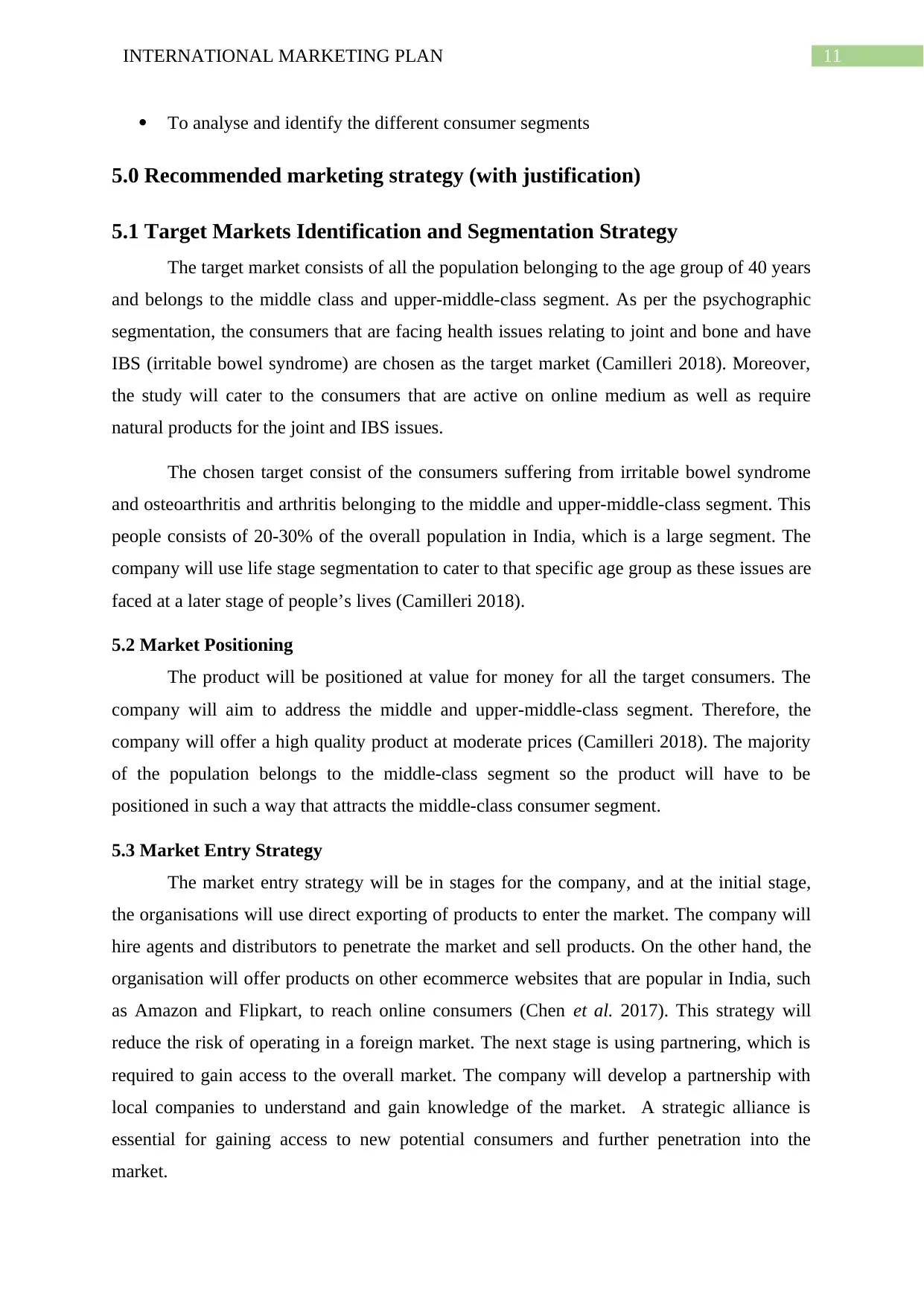
11INTERNATIONAL MARKETING PLAN
To analyse and identify the different consumer segments
5.0 Recommended marketing strategy (with justification)
5.1 Target Markets Identification and Segmentation Strategy
The target market consists of all the population belonging to the age group of 40 years
and belongs to the middle class and upper-middle-class segment. As per the psychographic
segmentation, the consumers that are facing health issues relating to joint and bone and have
IBS (irritable bowel syndrome) are chosen as the target market (Camilleri 2018). Moreover,
the study will cater to the consumers that are active on online medium as well as require
natural products for the joint and IBS issues.
The chosen target consist of the consumers suffering from irritable bowel syndrome
and osteoarthritis and arthritis belonging to the middle and upper-middle-class segment. This
people consists of 20-30% of the overall population in India, which is a large segment. The
company will use life stage segmentation to cater to that specific age group as these issues are
faced at a later stage of people’s lives (Camilleri 2018).
5.2 Market Positioning
The product will be positioned at value for money for all the target consumers. The
company will aim to address the middle and upper-middle-class segment. Therefore, the
company will offer a high quality product at moderate prices (Camilleri 2018). The majority
of the population belongs to the middle-class segment so the product will have to be
positioned in such a way that attracts the middle-class consumer segment.
5.3 Market Entry Strategy
The market entry strategy will be in stages for the company, and at the initial stage,
the organisations will use direct exporting of products to enter the market. The company will
hire agents and distributors to penetrate the market and sell products. On the other hand, the
organisation will offer products on other ecommerce websites that are popular in India, such
as Amazon and Flipkart, to reach online consumers (Chen et al. 2017). This strategy will
reduce the risk of operating in a foreign market. The next stage is using partnering, which is
required to gain access to the overall market. The company will develop a partnership with
local companies to understand and gain knowledge of the market. A strategic alliance is
essential for gaining access to new potential consumers and further penetration into the
market.
To analyse and identify the different consumer segments
5.0 Recommended marketing strategy (with justification)
5.1 Target Markets Identification and Segmentation Strategy
The target market consists of all the population belonging to the age group of 40 years
and belongs to the middle class and upper-middle-class segment. As per the psychographic
segmentation, the consumers that are facing health issues relating to joint and bone and have
IBS (irritable bowel syndrome) are chosen as the target market (Camilleri 2018). Moreover,
the study will cater to the consumers that are active on online medium as well as require
natural products for the joint and IBS issues.
The chosen target consist of the consumers suffering from irritable bowel syndrome
and osteoarthritis and arthritis belonging to the middle and upper-middle-class segment. This
people consists of 20-30% of the overall population in India, which is a large segment. The
company will use life stage segmentation to cater to that specific age group as these issues are
faced at a later stage of people’s lives (Camilleri 2018).
5.2 Market Positioning
The product will be positioned at value for money for all the target consumers. The
company will aim to address the middle and upper-middle-class segment. Therefore, the
company will offer a high quality product at moderate prices (Camilleri 2018). The majority
of the population belongs to the middle-class segment so the product will have to be
positioned in such a way that attracts the middle-class consumer segment.
5.3 Market Entry Strategy
The market entry strategy will be in stages for the company, and at the initial stage,
the organisations will use direct exporting of products to enter the market. The company will
hire agents and distributors to penetrate the market and sell products. On the other hand, the
organisation will offer products on other ecommerce websites that are popular in India, such
as Amazon and Flipkart, to reach online consumers (Chen et al. 2017). This strategy will
reduce the risk of operating in a foreign market. The next stage is using partnering, which is
required to gain access to the overall market. The company will develop a partnership with
local companies to understand and gain knowledge of the market. A strategic alliance is
essential for gaining access to new potential consumers and further penetration into the
market.
⊘ This is a preview!⊘
Do you want full access?
Subscribe today to unlock all pages.

Trusted by 1+ million students worldwide
1 out of 17
Related Documents
Your All-in-One AI-Powered Toolkit for Academic Success.
+13062052269
info@desklib.com
Available 24*7 on WhatsApp / Email
![[object Object]](/_next/static/media/star-bottom.7253800d.svg)
Unlock your academic potential
Copyright © 2020–2025 A2Z Services. All Rights Reserved. Developed and managed by ZUCOL.





